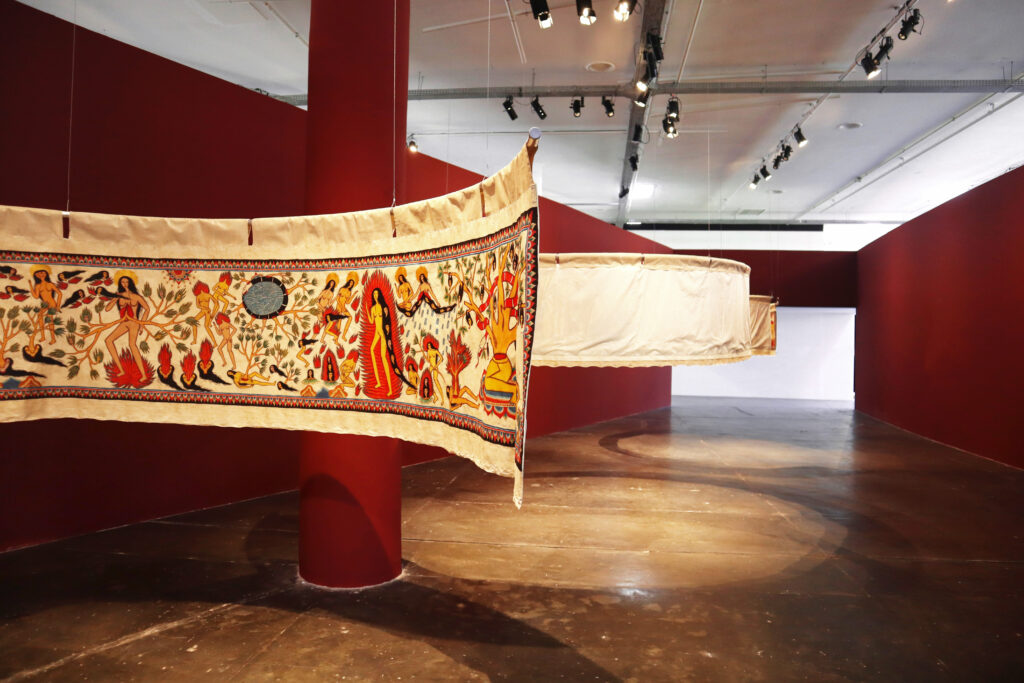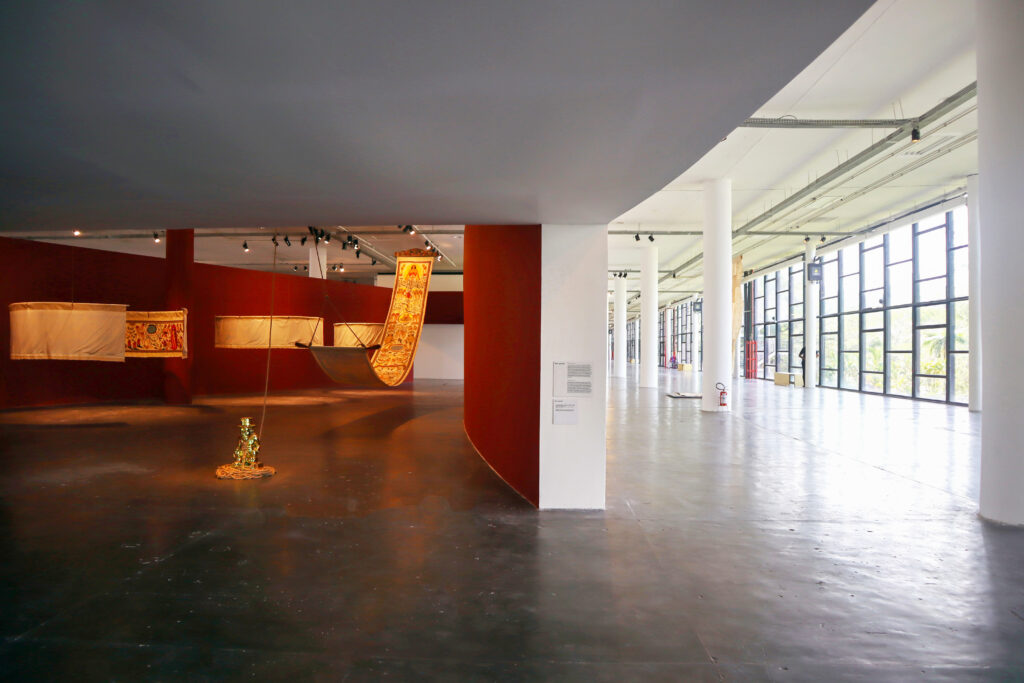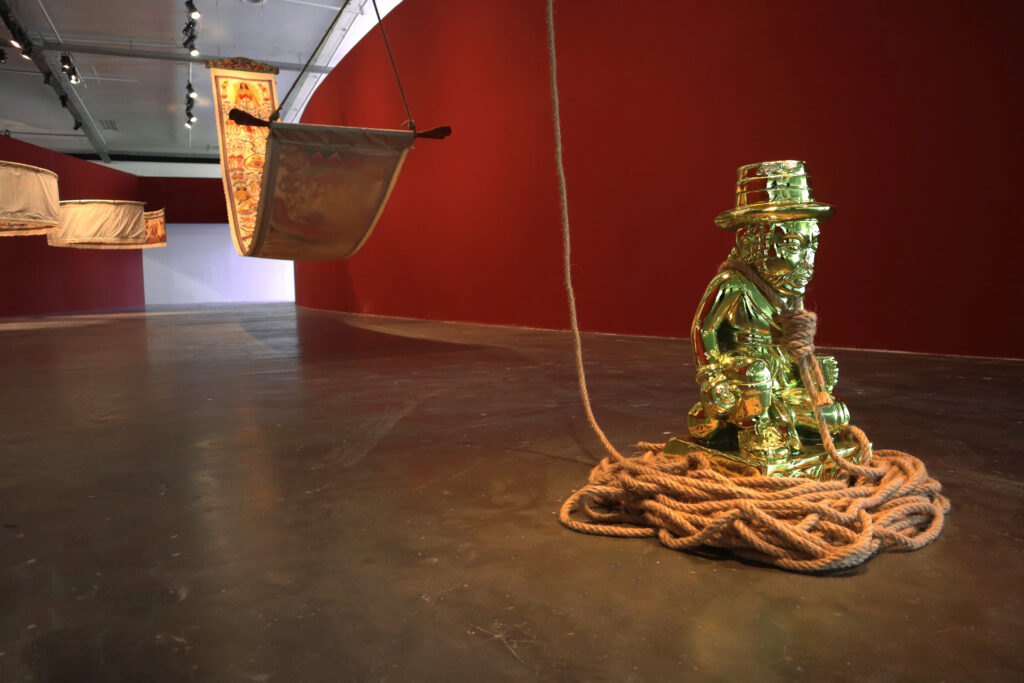

Artsy | The 35th São Paulo Bienal Revives Forgotten Memories
Ayanna Dozier , Artsy , September 23, 2023
Open a larger version of the following image in a popup:
Installation view, works by Citra Sasmita at the 35th Bienal de São Paulo – choreographies of the impossible © Levi Fanan / Fundação Bienal de São Paulo.
‘Memory burns. This is the overarching feeling at the 35th edition of the São Paulo Bienal, where collective memory is represented as both an endlessly fading and reemerging encounter within each artwork. This year’s Bienal, which opened to the public on September 6th and runs through December 10th, boasts one of the largest selection of artists to date: A staggering 121 names in total have work incorporated into the main pavilion at the Pavilhão Ciccillo Matarazzo, the official headquarters of the Foundação Bienal de São Paulo since 1957.
Additionally, Citra Sasmita’s immense figurative paintings on cowhide and canvas, made in the Indonesian Kamasan style, mythologize the terrors and tension surrounding femme bodies of color in the world and their never-ending fight for bodily autonomy. The rich, violent hues of crimson across the cowhide stand out and reveal shocking violence beneath the seemingly superficial, flat style. Sasmita’s work is one of the Bienal’s stunning discoveries.

Wallpaper | São Paulo Biennial 2023: activism, repressed cultures and South America's art history under the lens
Amah-Rose Abrams, Wallpaper*, September 23, 2023
The four curators of the São Paulo Biennial 2023, the 35th edition, chose the theme ‘Choreographies of the Impossible’ in order to allow themselves the freedom to create something truly radical. Ex-Reina Sofía director Manuel Borja-Villel, artist Grada Kilomba, independent curator Diane Lima, and anthropologist Hélio Menezes set themselves an enormous task; in today’s world, what is possible and for whom is complex – but the biennial’s theme offers up a level playing field for ideas of change. The free-of-charge, public-facing exhibition is installed in the long, post-industrial Ciccillo Matarazzo pavilion, lined by windows on both sides and set in the Parque do Ibirapuera, which acts as a backdrop for the works of the 120 participating artists on view.
‘We inhabit many different bodies, marked by geography, marked by colour, marked by age, marked by gender so that what is considered impossible for me can be completely different from other people,’ Menezes explained. ‘So, figuring out how to bring all that together here in the biennial was one of our goals, organising it by addressing how to put artistic and political expressions together that deal with impossibilities in their places, impossible territories, impossible bodies and impossible contexts.’
There is a new representation of Indigenous communities from Brazil around the world, including the moving tribute to lost defenders of the Amazon Rainforest Floresta de infinitos, 2023, placed alongside works by Ahlam Shibib, Amos Gitaï and Kamal Aljafari looking at Israel and Palestine and a stunning, large-scale living work Non-Negotiable Condition, 2021, by Daniel Lie. Citra Sasmita’s exploration of misconceptions of Balinese culture through narratives painted onto large banners, Timur Merah Project IX: Beyond the Realm, 2023, is a standout work.
‘Choreographies of the Impossible’ set itself a difficult task, to give a level playing field to all ideas in an art world that can be obsessed with faddism and categorisation of the human condition, struggle and conflict – and it succeeded. The relief in the room at the opening was palpable, the smiles were huge, and the art was fantastic.
‘The idea of what lies ahead, the idea of the future is a little bit less distant right now,’ said Lima on opening day.


ArtThrob | Return to the body: 35th São Paulo Bienal – Choreographies of The Impossible
Keeely Shinners, ArtThrob , September 15, 2023
A new enlightenment is sweeping through that sub-class of the bourgeoisie that is the contemporary art world. You may have heard of it. It is a way of thinking comprising not isms but alities: materiality, temporality, corporeality, sensorality, spirituality. It is distrustful of representation, but fixed firmly in identity, specifically that of the oppressed. It sees time not as progressive or even linear, but helical. It understands that the world is marked by histories of colonial and patriarchal violence, but it does not want to trade in violent imagery. Instead, it lingers in absence, erasure and lack. The syllabus is that of the Black North American intellectuals writing lyrically about the “terrible beauty” of the transatlantic diaspora: Saidiyah Hartman, Christina Sharpe, Dionne Brand. Its politics are not organised around the 19th century pursuit of “freedom” and “liberty,” nor the “liberation” and “solidarity” of the 20th. “Justice” and “transformation,” the refrain of our parents’ generation, is similarly eschewed. “Decolonisation,” a word we picked up when we were students, has also been discarded. Instead, this is a politics of “collectivity” and “collaboration.” Indeed, it falls more in the camp of ethics and epistemology than in the realm of politics, traditionally understood. If it is a politics, it is a politics not of movements but gestures. If it is a revolution, it is a revolution happening on the level of poetics. A revolution of discourse, affect and minor acts of resistance. It is this enlightenment that is guiding the various collectives of curators (and they are almost always collectives) that I met over the course of one week in São Paulo on the occasion of choreographies of the impossible, the 35th edition of the São Paulo Bienal.
Onto the second floor, where Adams’ lungs pump. Marlon Riggs’ Tongues Untied (1989) is the heart pulsating with as much anger as there is water in the body, to paraphrase a line from the film. A blood-red painted room contains Citra Sasmita’s Timur Mirah Project IX: Beyond the Realm of Senses (Oracle and Demons), which is all about the arteries and veins that connect tree to woman to snake to hair to sun to skin.